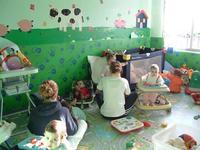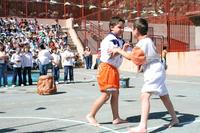

Whether you wish your children to follow the Italian system of education or go to an international school is a very personal choice and depends on the age of the child, how long you plan to stay in Italy, where the child will study next and on your view as to the benefit of learning Italian in the local system.
Often parents with young children (<5 years) find that sending the child to the local nursery (called either asilo nido or scuola maternal) is a great chance to make local friends and learn Italian while parents of older children who are more concerned about not interrupting their education, send their children to a British, American or International school to allow easier integration when they return home. As these international schools are often found only in large cities, the choice of schooling and housing go together. It is worth exploring the options a bit before deciding as the experience your children will have will vary considerably depending on your choice.
|
Type |
Age range |
Comment |
|
Asilo Nido (nursery) |
3 months to 3 years |
Comune run, place not guaranteed for every child, cost depends on parents joint income |
|
Scuola Materna or asilo (kindergarten) |
3 –6 years |
State run, guaranteed place, free |
|
Scuola Elementare (primaria) |
Grades 1-5, 6 – 10 years |
State run, guaranteed place, free |
|
Scuola Media |
Grade 6 –8, 11-13 years |
State run, guaranteed place, free |
|
Liceo Or Istituto Tecnico Or Istituto Professionale |
14 – 18 years |
More academic students chose from Liceo Classico, Scientifico, Linguistico or artistico Less academic students choose a vocational training. |
These are run by the local comune usually to an impressive standard. Meals are planned by a dietician and are famous in Italy for their quality! Comune run nurseries are usually a higher standard than private. To register you fill out a simple form (available from the comune or asilo nido itself). Costs vary from place to place (even in the same region) and usually depends on parental income. Typical opening hours are 9.00-16.00 though many have extended hours for working parents opening from 7.30 to 18.30. They close for Easter, Christmas, Nati

onal bank holidays and a limited time in the summer.
These are state run and every child is entitled to a place. There are no fees. Children do not learn to read or write until they go to scuola elementare (now called scuola primaria) but follow a structured curriculum of creative activity, learning songs/poems, school trips etc. The lunch menu is again designed by a dietician and is sets the culinary standard for the future!
Typical opening hours are 9.00-16.00 though many have extended hours for working parents opening from 7.30 to 18.30. Holidays are similar to those of the asilo nido during the year but have longer summer holidays (July, August, half Sept). Summer schools are often available to working parents.
These are state run, free and attendance is compulsory for Italian children. Children learn to read and write and cover the following subjects: mathematics, geography, science, music, Italian, English, religion (optional), social studies.

Scuola media is compulsory for all children and covers a wide breadth of subjects as part of the curriculum. After 3 years children take an examination to graduate with a primary school diploma ( Licenza Elementare). Lessons are often morning only 8.00 – 13.00 and children do homework or extra activities I the afternoon (outside school). School hours vary considerably from regional to region. The school year is similar to that of scuola elementare (see above).
There are different liceo courses that children can take which specialise in particular areas: classico (latin, greek), scientifico (sciences), linguistico (foreign languages), artistico (fine arts).
All students study the basics (Italian, history, mathematics, foreign language, geography etc) in addition to the specialisation above. Children who expect to attend university will attend the Liceo. Children who do not intend to go on to University can study instead a technical or vocational course e.g. accountancy, farming, hotelier etc.
The best start point is the website http://www.ecis.org which gives a list of 32 international schools in Italy. They tend to be based in big cities (Rome, Milan, Naples, Florence etc). There is a database which describes the type of curriculum the school follows and useful information such as fees, ages catered for, nationality mix of students (a surprising number of Italian parents send their children to International schools to improve their English), classes numbers etc. These schools usually follow the curriculum of the home country with additional lessons in Italian (and often English).It is worth asking other foreigners in your at work for further insights. Your embassy should also be of help.
By Helen Burgess, Insight Italy
Relocation and integration services
http://www.insight-italy.com/